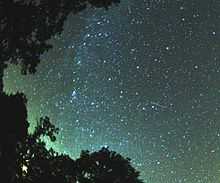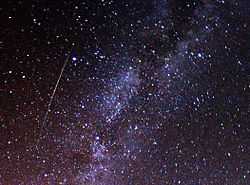Perseids
| Perseids (PER) | |
|---|---|
|
A multicolored, long Perseid striking the sky just to the left of Milky Way, 2009 | |
| Pronunciation | /ˈpɜrsiːɨdz/ |
| Discovery date | 36 AD (first record)[1][2] |
| Parent body | Comet Swift–Tuttle[3] |
| Radiant | |
| Constellation | Perseus |
| Right ascension | 03h 04m[3] |
| Declination | +58°[3] |
| Properties | |
| Date of peak | August 12[3] (July 23–August 20)[3] |
| Velocity | 58[4] km/s |
| Zenithal hourly rate | 80[3] |

The Perseids /ˈpɜrsiːɨdz/ are a prolific meteor shower associated with the comet Swift–Tuttle. The Perseids are so called because the point from which they appear to come, called the radiant, lies in the constellation Perseus. The name derives in part from the word Perseides (Περσείδες), a term found in Greek mythology referring to the sons of Perseus.
The stream of debris is called the Perseid cloud and stretches along the orbit of the comet Swift–Tuttle. The cloud consists of particles ejected by the comet as it travels on its 133-year orbit.[5] Most of the particles have been part of the cloud for around a thousand years. However, there is also a relatively young filament of dust in the stream that was pulled off the comet in 1865, which can give an early mini-peak the day before the maximum shower.[6]
The earliest information on this meteor shower is found in Chinese annals in A.D. 36. However, credit for recognising the shower's annual appearance is given to Adolphe Quetelet, who reported in 1835 that there was a shower emanating from the constellation Perseus.[1][2] Some Catholics refer to the Perseids as the "tears of Saint Lawrence", since 10 August is the date of that saint's martyrdom.[7]
The shower is visible from mid-July each year, with the peak in activity between 9 and 14 August, depending on the particular location of the stream. During the peak, the rate of meteors reaches 60 or more per hour. They can be seen all across the sky; but, because of the path of Swift-Tuttle's orbit, Perseids are primarily visible in the Northern Hemisphere. As with many meteor showers, the visible rate is greatest in the pre-dawn hours, since the side of the Earth nearest to turning into the sun scoops up more meteors as the Earth moves through space. Most Perseids disappear while at heights above 80 kilometres (50 mi).[8]
| Year | Perseids active between | Peak of shower |
|---|---|---|
| 2015 | July 17 – August 24 | August 12–13[9] (ZHRmax 100?) (New moon Aug 14) |
| 2014 | July 17 – August 24 | August 13 (ZHRmax 68)[10] (Full moon Aug 10) |
| 2013 | July 17 – August 24 | August 12 (ZHRmax 109)[11] |
| 2012 | July 17 – August 24 | August 12 (ZHRmax 122)[12] |
| 2011 | July 17 – August 24 | August 12 (ZHRmax 58)[13] (Full moon Aug 13)[14] |
| 2010 | July 23 – August 24 | August 12 (ZHRmax 142)[15] |
| 2009 | July 14 – August 24 | August 13 (ZHRmax 173) (the estimated peak was 173,[16] but fainter meteors were washed out by a gibbous Moon.) |
| 2008 | July 25 – August 24[17] | August 13 (ZHRmax 116)[17] |
| 2007 | July 19 – August 25[18] | August 13 (ZHRmax 93)[18] |
| 2006 | 12/13 August[19] | |
| 2005 | ||
| 2004 | August 12 (ZHRmax >200)[4] | |
| 1992 | August 11 outburst under an Aug 13 full moon[20] |
References
- ↑ 1.0 1.1 Dr. Bill Cooke; Danielle Moser & Rhiannon Blaauw (2012-08-11). "NASA Chat: Stay ‘Up All Night’ to Watch the Perseids!" (PDF). NASA. p. 55. Retrieved 2013-08-16.
- ↑ 2.0 2.1 Gary W. Kronk. "Observing the Perseids". Meteor Showers Online. Retrieved 2009-08-12.
- ↑ 3.0 3.1 3.2 3.3 3.4 3.5 Moore, Patrick; Rees, Robin (2011), Patrick Moore's Data Book of Astronomy (2nd ed.), Cambridge University Press, p. 275, ISBN 0521899354
- ↑ 4.0 4.1 Żołądek, P. et al. (October 2009), "The 2004 Perseid meteor shower - Polish Fireball Network double station preliminary results", Journal of the International Meteor Organization 37 (5): 161–163, Bibcode:2009JIMO...37..161Z
- ↑ Dan Vergano (2010-08-07). "Perseid meteor shower to light up night sky this weekend". Usatoday.com. Retrieved 2013-08-12.
- ↑ Dr. Tony Phillips (June 25, 2004). "The 2004 Perseid Meteor Shower". Science@NASA. Retrieved 2010-03-12.
- ↑ "Science: Tears of St. Lawrence". TIME. 1926-08-23. Retrieved 2009-08-12.
- ↑ "NASA All Sky Fireball Network: Perseid End Height". NASA Meteor Watch on Facebook. 2012-08-11. Retrieved 2012-11-19.
- ↑ "How to See the Best Meteor Showers of the Year: Tools, Tips and 'Save the Dates'". nasa.gov. Retrieved 2013-07-29.
- ↑ "Perseids 2014: visual data quicklook". Imo.net. 2014-08-13. Retrieved 2014-08-13.
- ↑ "Perseids 2013: visual data quicklook". Imo.net. 2013-09-23. Retrieved 2014-04-20.
- ↑ "Perseids 2012: visual data quicklook". Imo.net. 2012-10-22. Retrieved 2014-04-20.
- ↑ "Perseids 2011: visual data quicklook". Imo.net. 2011-10-06. Retrieved 2014-04-20.
- ↑ "How to See the Best Meteor Showers of the Year: Tools, Tips and 'Save the Dates'". nasa.gov. Retrieved 2010-11-16.
- ↑ "How to See the Best Meteor Showers of the Year: Tools, Tips and 'Save the Dates'". nasa.gov. Retrieved 2010-08-12.
- ↑ "Perseids 2009: visual data quicklook". Imo.net. 2010-04-26. Retrieved 2009-08-11.
- ↑ 17.0 17.1 "Perseids 2008: visual data quicklook". Imo.net. 2009-06-06. Retrieved 2009-08-11.
- ↑ 18.0 18.1 Perseids 2007: first results
- ↑ EAAS
- ↑ Brown. "The Perseids 1992. New outburst announces return of P/Swift-Tuttle". Bibcode:1992JIMO...20..192B.
External links

 Media related to Perseids at Wikimedia Commons
Media related to Perseids at Wikimedia Commons- Worldwide viewing times for the 2014 Perseids meteor shower
- Gary Kronk's Meteor Showers page
- Perseid Observing Conditions (The International Project for Radio Meteor Observation)
- 2014 Perseids Radio results (RMOB)
- Perseid Visibility Map (2014 NASA Meteoroid Environment Office)
- 2009 Perseid Meteor Fireball
- NASA website on the Perseid shower of 2009
- Sky & Telescope Magazine - Perseids at Their Prime
- 2012 Image of Perseids emanating from the radiant
| |||||||||||||||||||||
